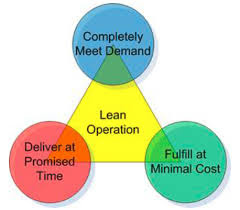Lean management
is a methodology that improves business results by striving for less waste throughout the process. Already widely known in the production industries, the lean concept is now starting to gain ground in the e-commerce sector. Lean management places the customer first — whereby the organization must identify the wishes of the customer and assess the customer’s perception of the value — which makes it a very promising concept for the e-commerce sector.
Why lean management?
is a methodology that improves business results by striving for less waste throughout the process. Already widely known in the production industries, the lean concept is now starting to gain ground in the e-commerce sector. Lean management places the customer first — whereby the organization must identify the wishes of the customer and assess the customer’s perception of the value — which makes it a very promising concept for the e-commerce sector.
Why lean management?
Online customers are extremely price-conscious and tend to compare product prices, often aided by price comparison websites. On average, online customers visit three websites before proceeding to make a purchase. This is especially the case for commodity products1. If an e-tailer wants to establish a competitive price offer, they will have to strive for optimal efficiency in their processes.
Online consumers also expect ever-faster delivery times. In order to be able to deliver quickly, it’s important to have an excellent logistics network2. Lean management can make a significant contribution to this, given that the methodology is focused on shortening the turnaround time.
It is also increasingly important that companies have a sustainable image. While in 2012 approximately 56% of consumers surveyed worldwide attached great importance to ecological problems, this figure had increased to 61% by 20153. Furthermore, in the past year, 70% of firms (surveyed in the United Kingdom) said that their top executives recognize a sustainable image as a driver for growth and innovation4. Needless to say, a concept based on the minimum amount of waste fits perfectly in this picture.
Three phases to implementing the lean concept
Lean management in distribution is based on three main pillars: being able to respond to (the complete) demand, delivering at the promised date and time and keeping stocked at the minimum possible expense.
- Being able to respond the demand
- Delivering at the promised date and time
If e-tailers want 100% satisfied customers, they must deliver the exact products that have been ordered without any damage. In a distribution environment, there is a real possibility that something could go wrong — especially if a lot of (manual) handling processes are involved. Real-time lean management focuses on the immediate detection of irregularities in the process. For example, by noting quickly that a product has been damaged, problems can be avoided further down the line and the customer will receive his or her order in the expected condition.
3. keeping stock at the minimum possible expense
Lean management can also help to prevent the buffering of goods, such as through the use of dynamic order intake via software applications. By training employees properly to ensure orders are processed as soon as possible, orders can be dispatched quicker and the need for carrying excess stock disappears.
Furthermore, it is important to eliminate unnecessary process steps and handle leads to reduce costs. The maximization of variable costs and the minimization of fixed costscan contribute to a lower cost price overall — and a more attractive retail price5.


Reacties